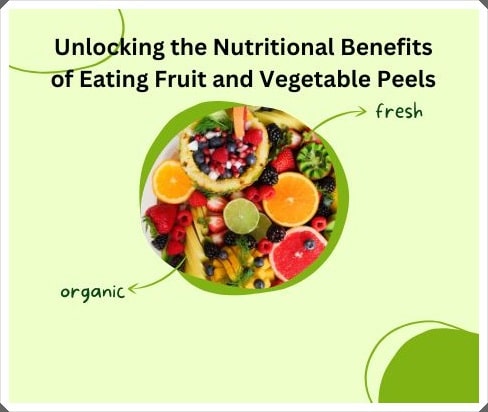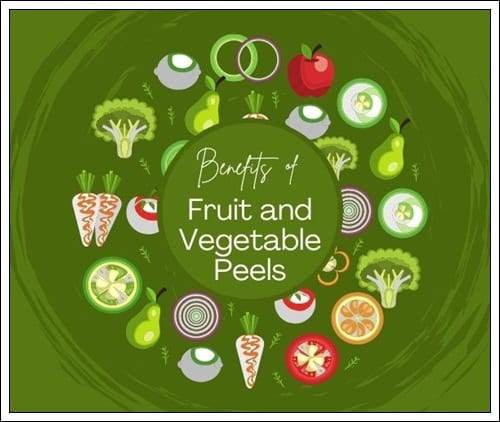
Did you know that you’re likely throwing away a goldmine of nutrients every time you peel your fruit or vegetable? We’re conditioned to discard peels, but these often-overlooked “scraps” are actually packed with fiber, vitamins, minerals, and antioxidants – offering a significant boost to your health, especially when sourced organically. This habit of discarding peels also contributes to the growing problem of food waste. But there’s good news! By understanding the nutritional powerhouse hidden within peels, and focusing on organic options, we can unlock a wealth of benefits for our bodies and the planet.
This article will explore the amazing nutritional value of edible peels, focusing on the importance of organic produce, and provide practical tips and delicious recipes to help you incorporate these nutrient-rich powerhouses into your diet. Get ready to rethink your relationship with fruit and vegetable peels!
Which peels are safe to eat?
There exists a wide variety of fruits and vegetables. However, a pertinent question arises regarding which peels of these produce are safe for consumption and which should be avoided. This inquiry often leads to confusion and necessitates thorough research prior to incorporating such information into daily dietary practices. Many individuals find themselves uncertain about which peels to include in their diet for optimal health benefits and which to exclude. In this discussion, we have compiled a list of various fruit and vegetable peels that are easily digestible and safe to consume. For further information, please refer to the details provided below concerning the different types of fruit and vegetable peels that are not advisable to eat.
Nutritional Benefits of Fruit and Vegetable Peels

1. High Fiber Content
- Digestive Health: Peels are rich in dietary fiber, which aids digestion and promotes regular bowel movements.
- Satiety: The fiber in peels helps you feel fuller longer, potentially aiding in weight management.
2. Vitamins and Minerals
- Vitamin C: Citrus peels, such as those from lemons and oranges, are abundant in vitamin C, bolstering the immune system.
- Potassium: Banana peels contain potassium, essential for heart health and muscle function.
3. Antioxidants and Phytochemicals
- Oxidative Stress Reduction: Antioxidants in peels combat oxidative stress, reducing the risk of chronic diseases.
- Phytochemicals: Compounds like flavonoids and polyphenols in peels have anti-inflammatory and anticancer properties.
Common Edible Peels and Their Specific Benefits
1. Apple Peels
- Nutrient Profile: Rich in fiber and quercetin, apple peels support heart health and have anti-inflammatory effects.
2. Potato Skins
- Nutrient Profile: Packed with potassium and vitamin C, potato skins aid in maintaining healthy blood pressure and immune function.
3. Citrus Peels (Lemon, Orange)
- Nutrient Profile: High in vitamin C and flavonoids, citrus peels can boost immunity and improve skin health.
4. Cucumber and Zucchini Skins
- Nutrient Profile: These skins provide fiber and antioxidants, promoting hydration and skin health.
5. Eggplant Skin
- Nutrient Profile: Contains nasunin, an antioxidant that supports brain health and protects cell membranes.
Safety Considerations
While peels offer numerous benefits, it’s essential to consume them safely.
1. Pesticide Residue Concerns
- Washing: Thoroughly wash and scrub peels to remove dirt and pesticide residues.
- Organic Produce: Opt for organic fruits and vegetables when possible to minimize exposure to harmful chemicals.
2. Proper Cleaning Methods
- Vinegar Solution: Soak produce in a solution of water and vinegar to help eliminate bacteria and pesticides.
- Produce Brushes: Use a brush to scrub firm fruits and vegetables under running water.
3. Peels to Avoid
- Avocado Skins: Tough and bitter, avocado skins are not palatable and can be difficult to digest.
- Melon Rinds: Certain melon rinds are hard and may contain compounds that are not suitable for consumption.
Culinary Uses for Peels
Incorporating peels into your meals can be both nutritious and delicious.
1. Incorporating Peels into Recipes
- Citrus Zest: Grate lemon or orange peels to add a burst of flavor to baked goods, salads, and marinades.
- Smoothie Add-ins: Blend washed apple or cucumber peels into smoothies for added fiber and nutrients.
2. Making Homemade Stocks and Broths
- Vegetable Broth: Collect peels from onions, carrots, and potatoes to simmer into a flavorful and nutrient-rich broth.
3. Pickling and Fermenting
- Pickled Watermelon Rinds: Transform watermelon rinds into a tangy pickle, reducing waste and creating a tasty snack.
4. Creating Natural Flavorings
- Infused Oils: Steep citrus peels in olive oil to create aromatic dressings and cooking oils.
- Candied Peels: Boil and sugar-coat citrus peels for a sweet treat or cocktail garnish.
Environmental Impact
Embracing the consumption of peels extends benefits beyond personal health.
1. Reducing Food Waste
- Statistics: A significant portion of food waste comprises discarded peels, contributing to environmental degradation.
- Sustainability: Utilizing the whole fruit or vegetable minimizes waste and conserves resources.
2. Sustainable Practices
- Composting: If consuming peels isn’t feasible, composting them enriches soil and reduces landfill waste.
- Mindful Consumption: Making conscious choices about food usage promotes a sustainable lifestyle.
Here are a couple of simple recipes to get you started:
Candied Citrus Peels (using organic citrus):
- Wash and peel your organic citrus fruits.
- Cut the peels into strips.
- Simmer the peels in water until softened.
- Drain the peels and simmer them in a sugar syrup until translucent.
- Roll the peels in sugar and let them dry.
Apple Peel Tea (using organic apple peels):
- Wash and peel your organic apples (save the fruit for other uses!).
- Dry the peels slightly.
- Steep the peels in hot water for 10-15 minutes.
- Strain and enjoy your apple peel tea!
A Word of Caution: Not All Peels Are Created Equal
While many peels are edible and nutritious, it’s important to remember that not all peels should be consumed.
- Pesticide Concerns: Again, always prioritize organic produce when consuming peels to avoid pesticide residue.
- Unpleasant Textures/Tastes: Some peels can be tough, fibrous, or have an unpleasant taste.
- Specific Examples: While some eat mango peels, others find them irritating. Certain root vegetable peels might be difficult to digest. It’s best to research specific peels before consuming them.
Eating Peels: A Sustainable Choice
Consuming peels is not only good for your health; it’s also good for the planet.
- Food Waste Reduction: By eating peels, you’re reducing the amount of food waste that goes to landfills.
- Composting: If you choose not to eat certain peels, composting is a great alternative. Composting turns food scraps into nutrient-rich soil for your garden.
- Sustainable Practices: Eating peels is a small but significant step towards a more sustainable and conscious lifestyle.
Conclusion
Incorporating fruit and vegetable peels into your diet is a simple yet effective way to boost nutrient intake and support environmental sustainability. By understanding the benefits and practicing safe consumption, you can make informed decisions that positively impact your health and the planet.
FAQ: Eating Fruit and Vegetable Peels
1. Are all fruit and vegetable peels safe to eat?
Not all peels are edible. While many, such as apple, potato, and cucumber peels, are safe and beneficial, some peels, like avocado and melon rinds, are tough and difficult to digest. Always research specific peels before consuming them.
2. How do I safely clean fruit and vegetable peels?
To remove pesticides, dirt, and bacteria:
- Wash under running water while scrubbing with a brush.
- Soak in a vinegar-water solution (1:3 ratio) for a few minutes.
- Choose organic produce when possible to reduce pesticide exposure.
3. Do peels contain more nutrients than the flesh?
Yes! Many peels are richer in fiber, antioxidants, and vitamins than the flesh. For example, citrus peels contain more vitamin C and flavonoids than the inner fruit.
4. Are all fruit and vegetable peels edible?
No, not all peels are edible. While many peels offer significant nutritional benefits, some may be tough, fibrous, have an unpleasant taste, or even contain compounds that are not easily digestible. It’s crucial to research specific peels before consuming them. This article focuses on commonly consumed, beneficial peels, and emphasizes the importance of organic sources.
5. Why is it so important to choose organic produce when eating peels?
Organic produce is essential when consuming peels because the peel is directly exposed to the environment. Non-organic produce may contain pesticide residues that accumulate on the peel. Since you’ll be eating the peel, choosing organic minimizes your exposure to these potentially harmful chemicals.
6. How should I wash peels before eating them?
Thoroughly washing all produce, especially organic, is crucial. Use a vegetable brush to scrub away any dirt or residue. Rinsing alone is often not enough to remove potential contaminants.
Leave a Reply
You must be logged in to post a comment.